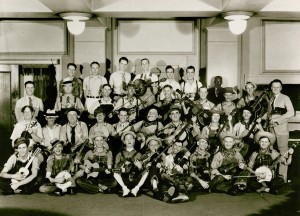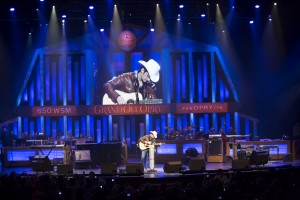In the current Grand Ole Opry theater, there is a six-foot square of wood cut from the home’s main original home, the Ryman Auditorium, which was home to an iconic range of musical stars from 1943 to 1974. As part of the Opry’s uninterrupted 88 years live on air, this piece of timber has a simple, but profound, purpose: to allow contemporary musicians and singers to perform on, literally, the same stage that the likes of Uncle Dave Macon and Patsy Cline did, years earlier.

No wonder, then, that an institution so steeped in tradition, has also turned its gaze to recording and collating the visual record of the too many to name stars, and more obscure artists, that have become a part of the longest-running radio show in America, that started in 1925, just five years after commercial radio was born in the United States.
Brenda Colladay, the Museum and Photo Curator for the Grand Ole Opry and Ryman Auditorium, oversees a vast collection of photos, both researched and donated. As she explains: ” Like any picturesque entertainment icon, there is great imagery associated with the Grand Ole Opry, and we have a photographic archive that spans from 1925 to today. It is comprised of candid backstage photos, transparencies, stills, and so on, of various events for the radio station, and the parent company; which was the National Life and Accident Insurance Company.”

©Grand Ole Opry, LLC
Comprised of 150,000 plus images, it contains a wide swathe of country music history, and, even more specifically, Nashville history. The Grand Ole Opry is still in the process of digitizing this huge collection: in Colladay’s words the resource is “more than anybody would ever possibly measure,” and that’s before they even get to the digital native material that photographers have been shooting since 2001 (comprising many more hundreds of thousand of images since then).
The original show was born at a time when archiving wasn’t exactly a priority, so the historical cultural value of this record seems – like most enterprises, be it punk rock, or old TV shows – to have only been realized much later. As Colladay explains:” The audio was very rarely recorded; only if an sponsor needed “air checks” to see if they were getting their money’s worth. In the mid 60s they created a program where they would sell the Grand ‘Ol Opry to other radio stations in the week, and that was all recorded, and pressed onto vinyl LPs, and sent out to 400 stations out over the country.”
Now, of course, The Grand Ole Opry records everything, both acoustically and visually, but it’s in hindsight that this remarkable collection has begun to try and fill in the gaps.
“They would come to realize the value of this as publicity, and that was always the impetus. We’re much lighter on the earlier days – from 1925 until 1950 – we have fewer images, before the 1950s onwards. We are always looking to find photographs that have [been] scattered over the years. This was a live radio show on a live radio station, that was broadcast seven days a week, and it was just live radio, so… it wasn’t recorded or documented, doing what you had to do every day and get the content out.”
The collection is mainly supplemented by those who might come across something in an attic, or want to trace their own relative’s contribution to the pantheon of music. Colladay indicates that the Grand Ole Opry doesn’t have a purchase budget, or necessarily, a way to advertise for materials, but that people “Often call the main office and say ‘Hey we have this,’ or there are family legends when people are told that their great great aunt performed in 1937, and do we have a recording and a video?”
It’s a common misconception – that we think that we used to record events in the 20th century in the same forensic detail that we do of our own lives today, on cell phones and the like – and Colladay gently acknowledges as such: “ The Grand ‘Ol Opry is like what they say about Woodstock: if everybody who said that they’d been here had been here… we couldn’t have fit the people in the building.”
However, the archive continues to accrue, and even though it’s fine to get new material on famous performers, often the most interesting contributions or finds are those relating to the more obscure performers, that might fill out the gaps in this unparalleled train of musicians and singers, both long-time icons and one-off performers. As Colladay indicates, she will happily accept any new pictures of Hank Williams, or Johnny Cash, “but it’s great when we can actually help someone document a family member, or illustrate a book.”
The archive is pretty much being built as a record, foremost, rather than specifically for commercial usage, but that is also clearly a target too. As Colladay indicates, “It’s mainly archival, for own use. Creating books, and advertising, and marketing, and the web site. We do license, over the last 15 years, and actively try to. We also have a range of video collections. Various TV shows, and so on. We have wonderful photographs and people want that, so…”

Chris Hollo photograph ©2013, Grand Ole Opry, LLC
They say that music can transport you instantly to a prior time in your life, but then they also say that a picture is worth a thousand words. Maybe the material at the grand Ole Opry is worth a 150,000 plus tunes too…
As Patsy said: ‘Carnegie Hall was real fabulous, but you know, it ain’t as big as the Grand Ole Opry.’
The Grand Ole Opry Archives can be sourced here: http://www.opry.com/photoarchives . They will also be at Visual Connections. Many thanks to Museum and Photograph Curator Brenda Colladay for the interview and photos.
